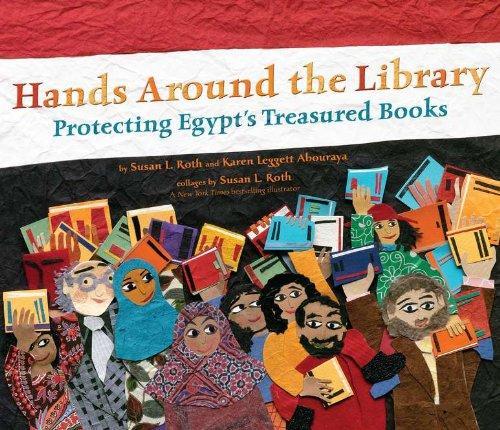
Hands Around the Library
Read Aloud Book: Hands Around the Library
Story: Rachel Rodríguez
Illustration: Julie Paschkis
ISBN-13: 978-0805077407
C3 Framework Key term: Place: A location having distinctive features that give it meaning and character and distinguish it from other locations.
Synopsis
Hands Around the Library: Protecting Egypt’s Treasured Books tells the story of protesters who protected the Alexandria Library from vandalism during the 2011 protests in Egypt. Beginning in January 2011 there were many organized protests for democracy and freedom. During one of the marches, large crowds approached the library in Alexandria and discovered that the library was not protected from potential damage to the books. People broke away from the march and stood together, holding hands to protect the library.
Discussion
Contextualize: The Alexandria library was built on the ashes of the Great Library of Alexandria that begun under Ptolemy I (305-285 BCE) and was completed by Ptolemy II (285-246 BCE). Ptolemy II asked rulers and scholars in different nations to contribute books to the library. He aimed to have the largest and most important book collection in the world. The library included both original and copied versions of manuscripts by famous philosophers, poets, and scientists. It also served as a research and learning, enabling local scholars to achieve highest knowledge level in almost all subjects. Ask: What does building a great library in Alexandria say about the importance of this city in the Hellenistic world? Say: Alexandria, because of it location and port, was the center of commerce. The library made the city a cultural and learning center. Note a fun fact: The Lighthouse at Alexandria, Egypt was one of the seven wonders of the ancient world.
Ethics Connection
Say: The preservation of ancient books helps scholars compare modern and ancient ethical thinking representing shared values and moral principles. Ask: In your opinion, how different are ancient and modern ethics? Say: Ethical decision-making in modern times is applied to situations that did not exist in ancient times (e.g., internet ethics). In addition, early philosophers considered individual examples rather than systematic principles. However, modern ethical thinking is still influenced by Aristotle, Socrates, and Plato, who argued that character virtues help one live life at its best and promote the well-being of self and others. On the board, write “knowledge of history, geography, and science promotes ethical decision-making.” Say: Write at least two paragraphs discussing this argument.
Fun Activity
Schedule a screening of the 45-minute Ancient History Documentary, Ancient Mysteries: The Lost Treasure of Alexandria Library. Ask students to comment on the ending statement: “I think the wonderful thing about the library of Alexandria is that they did it. That the Ptolemies were willing to support this group of scholars that didn’t do anything for the Greek economy, they didn’t bring in money, they didn’t make any contributions to Ptolemies’ life style, but they still supported it. It was a sense of learning for its own sake.” Ask: What is “learning for its own sake?” Say: This phrase contrasts learning goals (for gaining knowledge) and performance goals (for receiving a good report card or public status). The love of learning was considered virtuous in ancient times and is still a highly regarded virtue today.